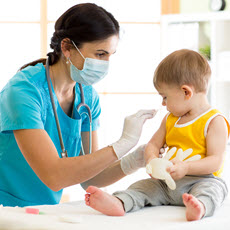Polio and Post-Polio Syndrome

Learn More
See, Play and Learn
Resources
For You
Summary
Polio is an infectious disease caused by a virus. The virus lives in an infected person's throat and intestines. It is most often spread by contact with the stool of an infected person. You can also get it from droplets if an infected person sneezes or coughs. It can contaminate food and water if people do not wash their hands.
Most people have no symptoms. If you have symptoms, they may include fever, fatigue, nausea, headache, flu-like symptoms, stiff neck and back, and pain in the limbs. A few people will become paralyzed. There is no treatment to reverse the paralysis of polio.
Some people who've had polio develop post-polio syndrome (PPS) years later. Symptoms include tiredness, new muscle weakness, and muscle and joint pain. There is no way to prevent or cure PPS.
The polio vaccine has wiped out polio in the United States and most other countries.
Centers for Disease Control and Prevention
Diagnosis and Tests
- Late Effects of Polio: An Overview (Post-Polio Health International including International Ventilator Users Network)
Prevention and Risk Factors
- Polio and Prevention (World Health Organization)
- Polio Vaccine (American Academy of Family Physicians)
- Polio Vaccine: What You Need to Know (Centers for Disease Control and Prevention) - PDF Also in Spanish
Treatments and Therapies
- Alternative Therapies (Post-Polio Health International including International Ventilator Users Network)
Living With
- Coughing (Post-Polio Health International including International Ventilator Users Network)
- Home Ventilator Guide (Post-Polio Health International including International Ventilator Users Network) - PDF
- Information about the Late Effects of Polio (Post-Polio Health International including International Ventilator Users Network) Also in Spanish
- Orthotics (Post-Polio Health International including International Ventilator Users Network)
- Poliomyelitis (World Health Organization) Also in Spanish
- Wellness (Post-Polio Health International including International Ventilator Users Network)
Related Issues
- Cold Intolerance (Post-Polio Health International including International Ventilator Users Network)
- Travelers' Health: Poliomyelitis (Centers for Disease Control and Prevention)
Images
- Polio Pictures (Centers for Disease Control and Prevention)
Statistics and Research
- Wild Poliovirus List (World Health Organization)
Clinical Trials
-
ClinicalTrials.gov: Poliomyelitis
 (National Institutes of Health)
(National Institutes of Health)
-
ClinicalTrials.gov: Postpoliomyelitis Syndrome
 (National Institutes of Health)
(National Institutes of Health)
Journal Articles References and abstracts from MEDLINE/PubMed (National Library of Medicine)
- Article: Update on Vaccine-Derived Poliovirus Outbreaks - Democratic Republic of the...
- Article: Talk to Patients About: Polio.
- Article: Achieving the end game: employing "vaccine diplomacy" to eradicate polio...
- Polio and Post-Polio Syndrome -- see more articles
- Postpolio Syndrome -- see more articles
Find an Expert
-
National Institute of Allergy and Infectious Diseases

-
National Institute of Neurological Disorders and Stroke
 Also in Spanish
Also in Spanish
- Post-Polio Directory 2014: Post-Polio Clinics, Health Professionals, Support Groups (Post-Polio Health International including International Ventilator Users Network) - PDF
- World Health Organization
Children
- Polio (For Parents) (Nemours Foundation) Also in Spanish
- Polio and the Vaccine (Shot) to Prevent It (Centers for Disease Control and Prevention) Also in Spanish
Patient Handouts
- Polio: Information for Parents (American Academy of Family Physicians, American Academy of Pediatrics, Centers for Disease Control and Prevention) - PDF
- Poliomyelitis (Medical Encyclopedia) Also in Spanish
